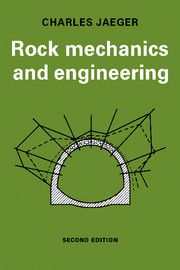Book contents
- Frontmatter
- Contents
- Preface
- Preface to the first edition
- Part 1 Introduction to rock mechanics
- Part 2 Rock material and rock masses
- Part 3 Rock mechanics and engineering
- Part 4 Case histories
- 12 Dam foundations and tunnelling
- 13 Incidents, accidents, dam disasters
- 14 The Vajont rock slide
- 15 Two examples of rock slopes supported with cables
- 16 Three examples of large underground hydro-power stations
- References
- Appendix 1 Comments on the bibliography
- Appendix 2 Measurement conversion tables
- Appendix 3 Table of geological formations and earth history
- Appendix 4 Some petrographic properties of rocks
- Author Index
- Index of geographical names, dam sites, reservoirs, tunnels and caverns
- Subject Index
16 - Three examples of large underground hydro-power stations
Published online by Cambridge University Press: 04 August 2010
- Frontmatter
- Contents
- Preface
- Preface to the first edition
- Part 1 Introduction to rock mechanics
- Part 2 Rock material and rock masses
- Part 3 Rock mechanics and engineering
- Part 4 Case histories
- 12 Dam foundations and tunnelling
- 13 Incidents, accidents, dam disasters
- 14 The Vajont rock slide
- 15 Two examples of rock slopes supported with cables
- 16 Three examples of large underground hydro-power stations
- References
- Appendix 1 Comments on the bibliography
- Appendix 2 Measurement conversion tables
- Appendix 3 Table of geological formations and earth history
- Appendix 4 Some petrographic properties of rocks
- Author Index
- Index of geographical names, dam sites, reservoirs, tunnels and caverns
- Subject Index
Summary
General information on tunnelling and underground work is given in the preceding chapters, mainly in part three. The case histories developed in this chapter concern the Kariba South Bank and the Kariba North Bank underground works, excavated in igneous rock and the Waldeck II machine house in sedimentary rock. In all three cases the rock required support. The methods used were very different in each case. It is interesting to compare designs, excavation techniques and rock support.
The Kariba South Bank power scheme (fig. 16.1)
The geology of the site (figs. 16.2 and 16.3)
The most impressive element of the Kariba power scheme is the high double-curvature arch dam impounding water in the Kariba Reservoir. Most of the geological investigation on the site was concentrated on the dam foundations and on the rock abutments on both sides (see section 11.4.3) and on the reinforcement work on the South Bank.
The geology of the Kariba area was recorded and interpreted by the late Dr Francis Jones and Dr Dubertret (Paris). Dr J. L. Knill and Dr K. S. Jones have published an extensive geological description of the area, including the areas where the South Bank and the North Bank underground power houses had to be located. They reported that:
The foundations of the dam are mainly composed of biotite, with occasional layers of amphibolite which are more abundant on the south bank.
- Type
- Chapter
- Information
- Rock Mechanics and Engineering , pp. 435 - 462Publisher: Cambridge University PressPrint publication year: 1979



